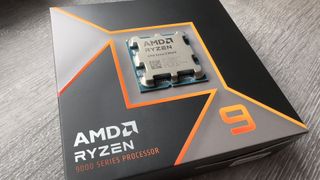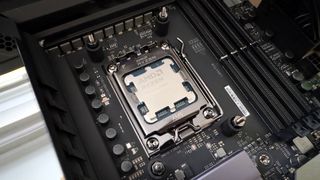Zen 5 revisited: Testing what a new BIOS and Windows update does for AMD's Ryzen 9000 chips
Ryzen 5 and 7 models get more power and all of them get better OS support. Good news, right?

It's fair to say the launch of AMD's launch of its Zen 5 desktop processors hasn't exactly been plain sailing, nor did the good ship Ryzen land on golden shores. With only a minor performance increase over the last-gen chips, the Ryzen 9000 series was met with universal disappointment and sales have apparently not been all that great, either.
There's nothing fundamentally wrong with the chips, though, as Zen 5 is faster than Zen 4. The Ryzen 9 9950X is a multi-threaded monster and the Ryzen 7 9700X and Ryzen 5 9600X are great CPUs for mainstream PCs. You wouldn't be disappointed with any of them.
The problem is that Zen 4 chips aren't actually that much slower, sometimes only by a few percent, and they are an awful lot cheaper to buy. On Amazon, the Ryzen 7 7700X is just under $250, whereas the 9700X is 30% more expensive at $324—the latter certainly isn't 30% faster the its predecessor.
However, during my testing, I never quite got the same performance figures AMD did and given that countless other reviewers experienced the same situation, something was clearly not right behind the scenes. Part of the answer appeared to be that AMD used a 'full admin' account on its test machines, which has certain optimisations for branch prediction that weren't present with standard user accounts, even the 'normal' admin ones.
In the games and applications we use to benchmark CPUs, the changes make virtually no difference.
That was resolved with the KB5041587 Windows update and motherboard vendors worked with AMD to release a BIOS that offered a 105 W TDP mode for the Ryzen 5 9600X and Ryzen 7 9700X (which normally run with a 65 W limit).
To that end, I've retested all of the chips again to see what performance benefit the Windows update and the higher power limit offers. If you don't want to go through all of the benchmarks for the answer, well here's the TL;DR version.
In the games and applications we use to benchmark CPUs, the changes make virtually no difference.
The biggest gaming news, reviews and hardware deals
Keep up to date with the most important stories and the best deals, as picked by the PC Gamer team.
Test procedure

Motherboard: Asus ROG Crosshair X670 Hero (2308 BIOS)
Cooler: Asus ROG Strix LC III 360
RAM: 32 GB Lexar Thor OC DDR5-6000
Storage: 2 TB Adata XPG Gammix S70
PSU: MSI MAG AB50GL 850 W
OS: Windows 11 23H2
Chassis: Open platform w/ 3x 140 mm fans
Monitor: Acer XB280HK
To give the Windows update and fresh BIOS the best possible chance of highlighting any improvements, I started from scratch with my AM5 test platform—stripping it right down, refitting every component, wiping the SSD, and starting with a fresh Windows 11 installation.
I also made sure that I followed AMD's testing guidelines word-for-word, including the enabling of core parking. This is really only for Ryzen processors that have two CCD (Core Complex Dies), namely the 9900X and 9950X.
What it does is when Windows detects a game is running, all threads are sent to CCD0 for testing. The other one is 'parked' and essentially does nothing.
This is also required for the Ryzen 9 7900X3D and Ryzen 9 7950X3D because these processors have extra L3 cache just on CCD0, so to ensure that games benefit from the 3D V-Cache, one needs to push threads onto that chiplet.
It's not super clear as to why the new Zen 5 dual-CCD chips need it too but it's perhaps because the inter-CCD latency is quite high and interferes with the improved branch prediction.
Whatever the case is, I tested the 9900X and 9950X with and without core parking enabled.
Single CCD results
Let's talk about the Ryzen 5 9600X and Ryzen 7 9700X first. In theory, they should still benefit from the Windows update but I was more interested in seeing how much better they would run when given a 105 W TDP limit (142 W max power limit).
As you can see, there are barely any gains to be had in games, and it's certainly not consistent. The 1% Lows are a little better with the 105 W limit but not enough to be excited about. The chips just aren't being loaded up enough to fully use all of that extra power, which is normal for gaming.
It's only when you switch to heavy, multi-threaded applications do you see any marked gains with the higher power limit.
But even then, it's nothing outstanding. An 11% increase in the Cinebench 2024 nT result, for a 56% increase in average power consumption proves that AMD was right to use a 65 W limit in the first place.
To me, that's good news, as it means if you bought a 9600X or 9700X right at launch, you weren't missing out on anything with the lower power limit. However, if you're into heavy overclocking, then you might be disappointed to see that you're not going to eke out more performance just by upping the power (unlike with Intel's chips).
It's possible that a little more performance might be found through further optimisations in Windows and AMD drivers, but I suspect both CPUs are as good as they're going to be.
Dual CCD results
The dual CCD Zen 5 processors, the Ryzen 9 9900X and 9950X, weren't given a new power limit. All that was on offer for them was the Windows update with the AMD-specific branch prediction optimisations, so let's see how they faired with the updated code.
As before, we'll look at the gaming results first, simply because that's where one is most likely to see any gains with better branch prediction. Workloads in the likes of Cinebench are fairly static.
First of all, it's clear that the branch prediction optimisations make no difference in our CPU gaming benchmarks. That doesn't mean they won't help out in every game or situation, but there was no evidence of any benefit in my tests.
What is interesting, though, is the fact the use of core parking made things worse. Only fractionally so in Cyberpunk 2077 and Baldur's Gate 3, but Metro Exodus and Total War: Warhammer 3 turned into total stutter-fests with it enabled. That said, core parking was generally better in Factorio but that test can be a little twitchy at times.
I can't recommend that anyone should bother with core parking
Unfortunately, I couldn't reuse the original results from Homeworld 3 in our Zen 5 reviews because there's been a patch since that time which has massively improved the overall performance, so there's no easy way to do a like-for-like comparison.
Anyway, AMD might insist that one should be using core parking with its dual CCD Zen 5 chips but I've not seen any evidence to suggest that one should. And given how damn awkward the whole process was, required repeated installations and reinstallations of drivers and multiple checks to finally get it to work, I can't recommend that anyone should bother with it.
For the content creation and heavy multithreaded benchmarks, the Windows update made no difference. Any discrepancies in the results are easily within the margins of test error. Since none of these are games, core parking is never activated, hence why it wasn't tested.
So just like the single CCD 9600X and 9700X, the twin chiplet monsters are as good as they're going to get. That's perfectly okay, as they're hardly slow processors, but if you were hoping for a magic software trick that would find a large chunk of missing performance, then you're going to be disappointed.
Those already on AM5 are going to be more than happy with what they've already got.
I suspect that most PC gamers won't really care, though. Those who are still on the older AM4 platform are probably just waiting to see what the 3D V-Cache variants are like before doing a major upgrade, and those already on AM5 are going to be more than happy with what they've already got.
Given all that we've seen with Zen 5, PC enthusiasts will want to temper their expectations of the likes of the Ryzen 7 9800X3D. The 9700X was only a little faster than the 7700X in gaming and content creation, so unless AMD has achieved an engineering marvel with the extra cache for Zen 5, then the 9800X3D is only going to be a little faster than the 7800X3D.
Still, there's always Zen 6, right? Right?

Nick, gaming, and computers all first met in 1981, with the love affair starting on a Sinclair ZX81 in kit form and a book on ZX Basic. He ended up becoming a physics and IT teacher, but by the late 1990s decided it was time to cut his teeth writing for a long defunct UK tech site. He went on to do the same at Madonion, helping to write the help files for 3DMark and PCMark. After a short stint working at Beyond3D.com, Nick joined Futuremark (MadOnion rebranded) full-time, as editor-in-chief for its gaming and hardware section, YouGamers. After the site shutdown, he became an engineering and computing lecturer for many years, but missed the writing bug. Cue four years at TechSpot.com and over 100 long articles on anything and everything. He freely admits to being far too obsessed with GPUs and open world grindy RPGs, but who isn't these days?
Most Popular


